The Future of Remote Work and Must-Watch Emerging Technologies
May 2, 2025

Remote work has become a cornerstone of modern business practices, driven by a combination of necessity and convenience. While the COVID-19 pandemic accelerated the shift to remote work, it’s clear that many organizations and employees now see the benefits that extend far beyond a crisis. As we look to the future, several emerging technologies are poised to reshape how remote work functions, making it more efficient, immersive, and seamless than ever before.
AI-Powered Collaboration Tools
One of the most significant trends in remote work is the rise of artificial intelligence (AI) to facilitate collaboration and productivity. AI-powered tools can automate mundane tasks, streamline workflows, and assist in decision-making processes. These tools can analyze data in real-time, optimize meeting scheduling, suggest improvements for productivity, and even assist with customer support.
What to Watch For:
- AI-driven project management tools that automatically track progress, assign tasks, and predict project timelines.
- Intelligent virtual assistants that help employees organize their day and prioritize tasks.
- AI-enhanced communication platforms that can provide real-time translation and transcription during meetings.
Virtual and Augmented Reality (VR/AR)
While VR and AR have long been associated with gaming and entertainment, their application in the remote work space is quickly expanding. Imagine being able to attend a virtual meeting in a lifelike 3D space or participate in a remote training session where you interact with a virtual object or environment. As the technology improves, VR and AR will create more immersive, engaging, and productive remote work experiences.
What to Watch For:
- VR-based team collaboration platforms where employees can meet in virtual environments.
- Augmented reality (AR) for enhanced remote troubleshooting, where experts can guide field technicians through complex repairs by superimposing instructions or diagrams on their device screen.
- Virtual whiteboards and interactive presentations for better team engagement and brainstorming sessions.

5G Connectivity
The global rollout of 5G networks is a game-changer for remote work. With its ability to deliver ultra-fast, low-latency connections, 5G will dramatically improve remote communication, especially in areas like video conferencing, live streaming, and large-scale data transfers. 5G will also enable more robust IoT (Internet of Things) capabilities, further supporting remote work environments.
What to Watch For:
- Seamless high-definition video conferencing, even with multiple participants and heavy data usage.
- Faster cloud access and file synchronization, improving collaboration on shared documents in real time.
- The ability to connect more IoT devices, creating a more integrated and automated remote work environment.
Cloud-based Security Solutions
As businesses continue to embrace remote work, data security becomes more critical than ever. Traditional security methods that focused on protecting physical office locations no longer apply when employees are working from various locations worldwide. Cloud-based security solutions are emerging as a way to secure data, manage user access, and monitor potential threats in real time.
What to Watch For:
- Zero-trust security models that authenticate every user and device, regardless of location.
- AI-driven threat detection systems that can identify and respond to cyberattacks in real time.
- Secure access solutions that allow workers to securely connect to their company’s network from any device, anywhere.
Digital Twins
Digital twins—virtual replicas of physical assets, systems, or processes—are becoming increasingly popular in industries like manufacturing, logistics, and construction. For remote workers, this technology can help create virtual workspaces and simulations of physical environments, allowing employees to interact with and manipulate complex systems remotely. This is particularly useful for remote maintenance or troubleshooting tasks.
What to Watch For:
- The use of digital twins for training remote workers, allowing them to practice in virtual environments before tackling real-world challenges.
- Remote workers in engineering, design, or construction being able to collaborate on virtual prototypes or blueprints in real time.
- Using digital twins to monitor remote facilities or machinery, enabling workers to respond to issues before they escalate.
Wearable Tech and IoT
Wearables, from smart glasses to fitness trackers, are becoming more integrated into remote work environments. These devices can enhance communication, health monitoring, and data collection, creating a more connected and productive work experience. For example, a remote worker might wear smart glasses to attend virtual meetings while having hands-free access to important documents.
What to Watch For:
- Wearable smart glasses that integrate with virtual collaboration tools for seamless, hands-free communication.
- IoT-enabled home office equipment that optimizes lighting, temperature, and ergonomics based on user preferences.
- Health monitoring wearables that help remote workers track physical and mental wellness, reducing burnout and improving overall productivity.

The Rise of the Metaverse
While still in its early stages, the Metaverse—the virtual world where users interact through avatars—has gained significant attention from tech companies and businesses. In the future, remote work could take place in fully immersive digital environments, where employees not only communicate and collaborate but also experience simulated office spaces, conference rooms, and social interactions.
What to Watch For:
- Virtual office spaces in the Metaverse where employees can meet, brainstorm, and socialize.
- A shift toward asynchronous work, with avatars of employees taking part in meetings or contributing to projects at their convenience.
- Tools that help businesses create and manage Metaverse experiences for training, recruitment, and client relations.
The Future is Hybrid and Tech-Driven
As the world continues to evolve, the future of remote work looks increasingly hybrid—where employees work from various locations, some in-person, some remote, while seamlessly collaborating across digital platforms. New technologies such as AI, VR/AR, 5G, and cloud-based security will make this vision a reality, enhancing productivity and fostering more dynamic and engaging work experiences.
The key to success in this new remote work landscape will be adapting quickly to these technological advances and leveraging them to create flexible, efficient, and secure work environments. Companies that stay ahead of these trends will not only attract top talent but also create long-term value by enabling their workforce to perform at their best, no matter where they are.
Have Any Question?
Call or email Cocha. We can help with your cybersecurity needs!
- (281) 607-0616
- info@cochatechnology.com



